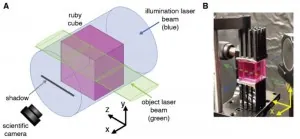
Shocking Discovery: Scientists Reveal That Laser Light Can Actually Cast a Shadow!
2024-11-18
Author: Charlotte
Introduction
In an astonishing twist to our understanding of optics, researchers have unveiled that laser light can indeed cast a shadow—an idea once thought to be purely philosophical. This ground-breaking finding challenges the conventional perception of how light interacts with itself and opens endless possibilities for innovative technologies.
The Discovery
“Traditionally, it was believed that light, by its very nature, passes through other light unhindered. Our findings are contrary to that intuition,” stated Raphael A. Abrahao, the research team leader from Brookhaven National Laboratory. He emphasized the need to rethink what we understand about shadows in light of this new evidence.
The Experiment
In the latest edition of Optica, the journal renowned for high-impact research, the team explained their groundbreaking experiment involving a ruby crystal and specific wavelengths of laser light. They demonstrated that under certain conditions, a laser beam can act like an opaque entity, thereby creating a visible shadow through a nonlinear optical process. This intriguing phenomenon occurs when varying intensities of light interact with materials in unexpected ways.
Significance of the Findings
“This revelation transforms our comprehension of light interaction,” said Abrahao, “This could lead to significant advancements in optical technologies such as optical switching and devices that allow one beam of light to control another.”
Inception of the Research
The researchers embarked on this exploration after a seemingly whimsical lunch conversation. They pondered whether the shadows depicted in 3D visualizations of lasers could ever materialize in the lab. What began as a lighthearted discussion soon evolved into serious scientific inquiry into laser physics and nonlinear responses of materials.
Experimental Setup
The experimental setup was ingenious. The researchers directed a high-power green laser through a ruby cube while simultaneously illuminating it with a blue laser. The interaction was remarkable: the green laser modified the ruby’s response to the blue light, thereby creating a visible shadow on a nearby screen. This dark patch indicated where the green laser effectively blocked the blue light, adhering to the definition of a shadow by being visible, shape-following, and position-specific.
The Science Behind It
The formation of this laser shadow stems from optical nonlinear absorption in the ruby. This interaction alters the absorption characteristics of the illuminating blue laser, resulting in a darker region behind the green beam—an awe-inspiring visual phenomenon.
Contrast Measurement
What's even more intriguing? The contrast between the shadow and the surrounding area measured around 22%. To put that into perspective, this is comparable to the contrast of a tree's shadow cast on a clear sunny day! The team not only observed this effect but also created a theoretical model to reliably predict the contrast levels of the laser shadows.
Future Implications
Looking ahead, Abrahao and his team are eager to explore the myriad applications stemming from this discovery, including the potential to manipulate the intensity of one laser beam using another. Exciting prospects loom as they plan to test additional materials and laser wavelengths, potentially uncovering even more mind-bending optical effects.
Conclusion
This remarkable research not only broadens our understanding of light-matter interactions but also hints at a future where light can be harnessed in new and innovative ways. The implications for communications, computing, and even energy transfer could redefine what we thought possible in the realm of technology.









 Brasil (PT)
Brasil (PT)
 Canada (EN)
Canada (EN)
 Chile (ES)
Chile (ES)
 España (ES)
España (ES)
 France (FR)
France (FR)
 Hong Kong (EN)
Hong Kong (EN)
 Italia (IT)
Italia (IT)
 日本 (JA)
日本 (JA)
 Magyarország (HU)
Magyarország (HU)
 Norge (NO)
Norge (NO)
 Polska (PL)
Polska (PL)
 Schweiz (DE)
Schweiz (DE)
 Singapore (EN)
Singapore (EN)
 Sverige (SV)
Sverige (SV)
 Suomi (FI)
Suomi (FI)
 Türkiye (TR)
Türkiye (TR)